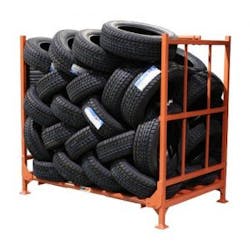Ask the Expert: Pros and cons of different tire storage methods
Question: Tires on the tread, barrel stacked, or laced: Which is the best?
Answer:
I have visited over 500 tire warehouses, from small to enormous. Every manager has their own preference for storing tires. Here are the pros and cons of the three methods.
On the tread
Pros:
- Effortless and quick to pick up or load.
- Simple to organize and easy to identify.
- Easy access storage area.
- Possible to store different sizes on the same racks.
- Low-cost storage system (for small quantities).
Cons:
- Difficult to load or unload when higher than three tiers.
- Needs a stepladder or an order picker.
In conclusion, if you are working in a small facility, such as a tire shop, garage, or a car dealership, or if you have a lot of small quantities and different sizes in your warehouse, storing tires on the tread is the best plan.
Lacing the tires
Pros:
- Saves up to 25-30 percent in storage space compared to the other methods.
- Saves time by moving large quantities of tires at once.
- Tires are stable in the racks since they are interlocked.
- Saves on racking equipment.
Cons:
- You can only lace the same tire SKU. No mixing.
- Tires are hard to pick when you need small quantities.
- Takes more time to load because of the lacing process.
- Can damage the tires if they stay in that position for too long.
- More difficult to take tire counts for your inventory.
This type of storage system is perfect for warehouses with large quantities of the same kind of tires.
Barrel stack
Pros:
- Uses less floor space and more vertical space, which is more profitable.
- Easy to do the picking.
- Saves time by moving large quantities of tires all at once.
- Easier to do the inventory of your tires.
- Very practical and easy to transport and stack.
- Unloads and loads quickly.
Cons:
- Tires are unstable and can fall off when you move the racks.
- Bottom tires can get a flat spot if they stay stacked for too long.
- Needs to have the same tire SKU throughout the rack.
This is the most common and cheapest way to store tires. It’s also very easy to work with.
Conclusion
These three methods all have great advantages, each responding to the specific needs of different types of companies. They all save floor space, handling time, and prevent injuries. Choose the one that works best for your situation.
Information provided by Martins Industries
